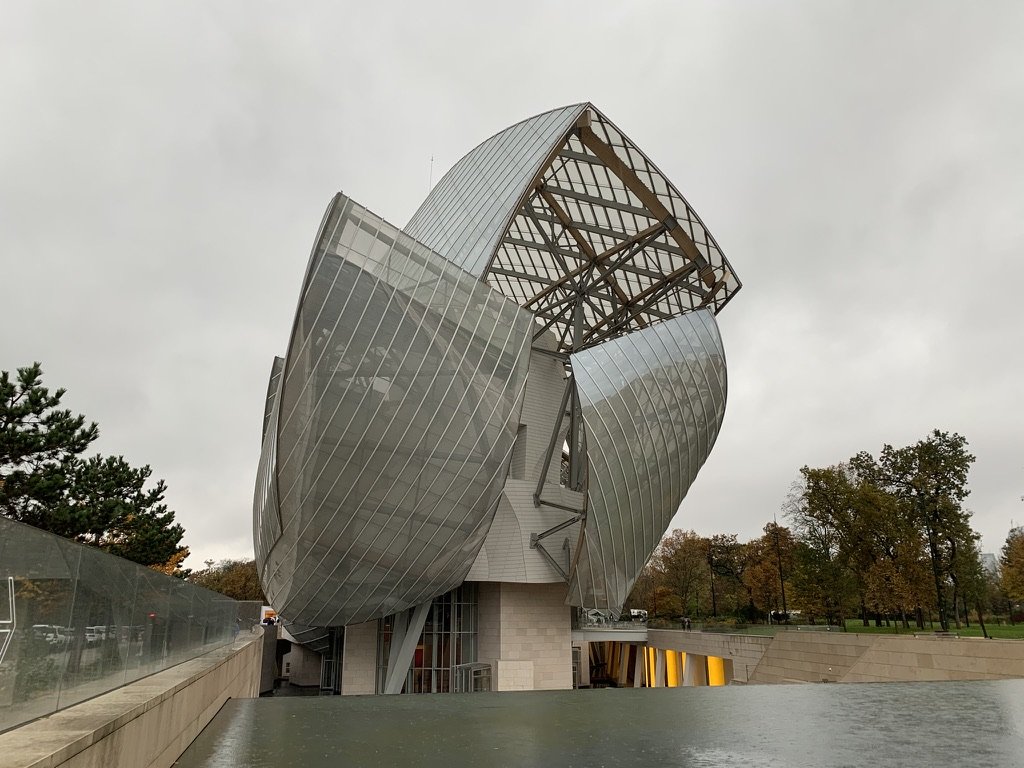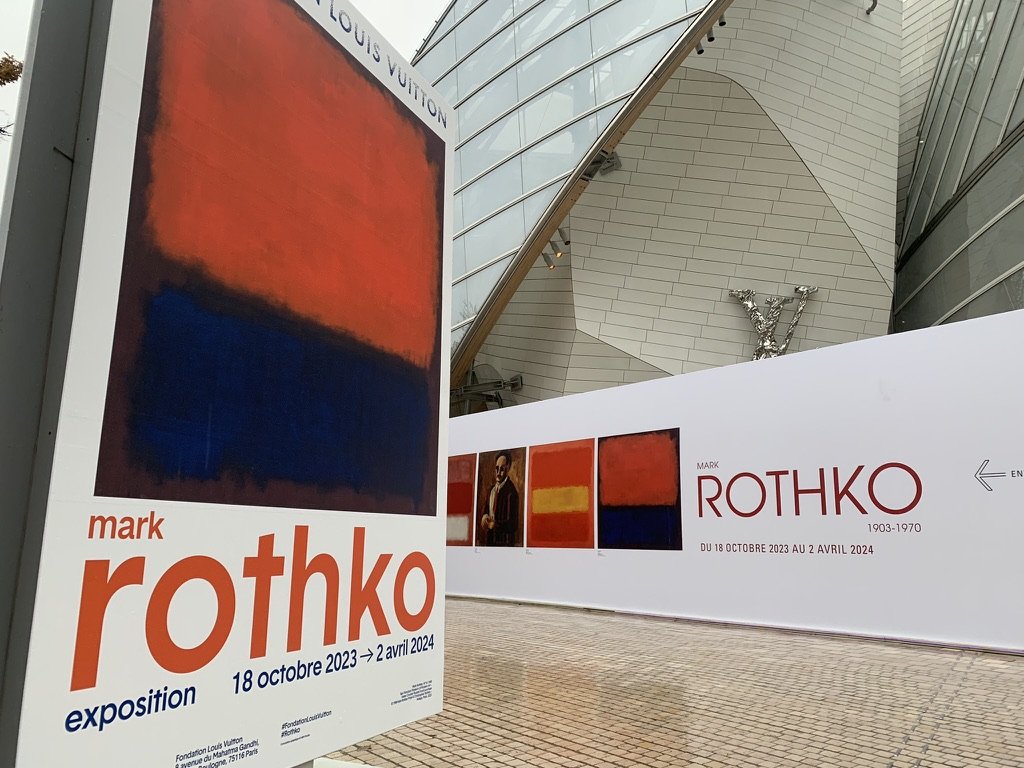
Fondation Louis Vuitton, Paris, FRance. Photo by Wendy Paris.
On a wet, cold Saturday in late November, Parisians lined up on the slick, cobbled plaza outside the Fondation Louis Vuitton (FLV), gripping umbrellas against the wind. The shiny, Frank Gehry-designed museum rose in the rain on the edge of the Bois de Boulogne, the city’s largest park, like a glass boat anchored in a cascading stream.
Driving rain could not squelch Parisians’ love of art (even as it made me long for a cozy booth in a warm bistro). The city had turned out for a multi-floor retrospective of American artist Mark Rothko, whose huge canvases generate hefty shipping fees that require deep pockets on the part of the organizer. In this case, those pockets were bulging with profits from enormously expensive handbags and wallets.
In a city whose streets are lined with ornate, 19th-century stone facades, or those even older, Fondation Louis Vuitton is a shot of hyper-modernity — and a shining sign of changing times in arts-focused philanthropy in France.
Arts patronage is nothing new for this city, of course. Paris was the center of the Western art world before World War II drove artists away. Today, the U.S. remains the world’s largest art market, with London a distant second. But the City of Light is experiencing a renaissance of art.
For one thing, Brexit has made it more expensive and time-consuming to trade art between London and the E.U., giving Paris a new appeal in the commercial art market. Several leading New York City-based and global private art galleries have recently opened branches in Paris, some citing a need to have a way to do business in the E.U.
Second, the rise of the global rich has created a growing demand for luxury goods, long a staple of the French economy. The resulting rising profits, combined with a tax law adopted in 2003 promoting corporate and private giving, are conspiring to bring more art to more people in France. As The Economist recently put it, “Private foundations, fueled by money-spinning luxury-goods firms, have raised the city’s artistic game.”
A good time to be in luxury goods
The FLV museum/cultural center is the nonprofit branch of LVMH Moët Hennessy Louis Vuitton, the Paris-based, multinational conglomerate specializing in luxury goods. The eye-catching museum was the vision of LVMH CEO Bernard Arnault, who until this fall was the second-richest man in the world. Opened in 2014 at a cost of some $900 million, FLV features 11 galleries across four (usually sunlit) floors, created from some 3,600 curved glass panels that form 12 “sails.” As Arnault said in a statement at the time, “We wanted to present Paris with an extraordinary space for art and culture, and demonstrate daring and emotion by entrusting Frank Gehry with the construction of an iconic building for the 21st century.”
So let’s talk about paying for it. LVMH recorded a 23% rise in revenue and profits in 2022 alone, based on increased sales in the U.S., Japan and Europe, according to the company’s website, which credits “a remarkable performance” by the fashion and leather goods business group, “notably Louis Vuitton, Christian Dior, Celine, Fendi, Loro Piana, Loewe and Marc Jacobs.” As the company explains, these brands have all gained market share globally and reached record levels of revenue and earnings. Other divisions pumping out profits include perfumes, champagne and cognac.
LVMH is not alone in channeling funds toward the arts. In 2021, the Bourse de Commerce — Pinault Collection opened in the old commerce building in Paris. Programming in this new space includes rotating exhibitions of more than 10,000 works held by French businessman François Pinault, founder of the luxury goods company Groupe Artémis. Bourse de Commerce is part of a larger art and culture project spearheaded by Pinault.
Another luxury-goods-backed art foundation getting a new building is the Cartier Foundation Center for Contemporary Art (Fondation Cartier por l’art contemporain). Established in 1984 by Alain Dominique Perrin, then president of the French jewelry and watch manufacturer Cartier International, the foundation supports up-and-coming artists, highlights established ones, and raises awareness about contemporary art. After 30 years in its old location, it plans to move into what will be the largest private art museum in the city, sometime in 2025, near the Louvre, allowing it to finally show its entire collection of 2,500 works, among other activities.
“Philanthropy? Bah, non! We paid for it.”
In some ways, France and the U.S. are on opposite trajectories when it comes to philanthropy. While here in the U.S., we have a long, robust philanthropic tradition — and a growing backlash against billionaires using their money to wield outsized influence in the public arena — France is moving in the other direction, newly embracing philanthropy, at least at the government level.
As a 2022 report from the Lilly Family School of Philanthropy at Indiana University put it, the government historically attempted to “control and narrow the scope of actions” of philanthropic organizations. But now, “from ignorance and mistrust, the government has progressively moved to establishing close relationships with the philanthropic sector.”

Fondation Louis Vuitton, Paris, FRance. Photo by Wendy Paris.
Ordinary Parisians, however, are not uniformly on board. While the Fondation itself is a big hit with Parisians, as evidenced by the crowds at the museum and people I spoke to in the city, the way it was funded raises some ire. “Philanthropy? Bah, non!” said the night manager at the hotel in Paris where I stayed, when I told him I was heading to FLV the next day to write about philanthropy. “Arnault said it was his money, but in the end, we paid for it with taxes.”
Was he right? Sort of. The arts-loving, billionaire-bashing hotel worker was referring to a 2003 law giving corporations a 60% tax deduction on philanthropic donations up to 5% of their annual income, and individuals a 66% deduction up to 20% of their taxable income. This law, largely credited with spurring the growth of philanthropy in France, is nonetheless viewed as a loophole by some.
Back in 2018, a watchdog group sued FLV over the construction of its giant art museum/jewel in the forest, saying the company had unfairly benefited from tax breaks to the tune of hundreds of millions of euros a year over the past decade. As ArtNet News put it at the time, “The dispute stems in part from growing dissatisfaction with France’s generous corporate philanthropy law… the so-called ‘Aillagon’ law,” named after the former minister of culture Jean-Jacques Aillagon, who championed the tax break.”
The lawsuit against FLV was eventually dismissed. While FLV was in the spotlight, in fact, the largest beneficiaries of the law have been some of the most celebrated cultural institutions in France, including the Louvre and the Château de Versailles. As another article in the same publication put it, private money has poured into public cultural institutions in France. “Today, almost all public museums, dance companies, orchestras and historic sites depend on corporate sponsorship and private donations to survive. The Aillagon Law has also helped fuel Paris’s private museum boom, as many are set up as nonprofit foundations.”
More arts funding likely
Has France decided to scale back the (at least somewhat) controversial tax breaks? No. French arts philanthropy continues, regardless of the discomfort some have with the mega rich creating mega monuments. In fact, a 2023 article in Le Monde cites a doubling of the number of charitable contributions declared to tax authorities by individuals between 2010 and 2021.
As Friends of Fondation de France (FFF), a nonprofit connecting American donors with charitable projects in France and other parts of the world, explained in its 2021 publication “National Giving Landscape,” French philanthropy is on the rise, with some U.S. philanthropic trends holding true in France. These include fewer donors giving more money, the rise of corporate philanthropy, and donors being moved by crises like Hurricane Irma, the Notre Dame Cathedral fire and COVID-19. As the same article in Le Monde put it, quoting a 2022 book on French philanthropy: “Giving today is as much about luxury billionaires becoming involved in the 48 hours after the Notre Dame fire in April 2019 as it is about a multitude of small sums that can change lives.”
The rise of luxury goods billionaires in France may well lead to the same kinds of problems we face here as a result of our ever-widening economic gulf — and it will perhaps generate another realm of philanthropic involvement there. For now, the global love of luxury goods remains good news for art lovers willing to brave long lines and crowded rooms to see contemporary and classic art in Paris.
This post was originally published on this site be sure to check out more of their content.








